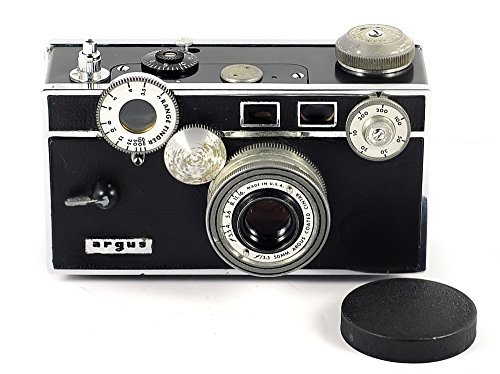Ever felt like you’re trying to hit a bullseye while wearing a blindfold? That’s sometimes what it feels like trying to focus a camera, especially when you’re new to film. But what if I told you there’s a camera type that makes it easier, more accurate, and gives your photos a cool, vintage vibe? Enter the world of rangefinder film cameras!
Choosing a rangefinder can be tough. There are so many different models, brands, and features to consider. You might get confused by the prices, the sizes, and the different lenses. This guide will help you understand these cameras. We’ll break down what makes them special and how to pick the best one for you. Forget the frustration and learn how to capture amazing shots with a rangefinder.
By reading on, you’ll learn what a rangefinder is, how it works, and why photographers love them. You’ll discover the pros and cons, and get tips on what to look for when buying one. You’ll also find some great camera recommendations! So, are you ready to ditch the guesswork and start taking stunning photos? Let’s dive in and explore the magic of rangefinder film cameras!
Our Top 5 Rangefinder Film Cameras Recommendations at a Glance
Top 5 Rangefinder Film Cameras Detailed Reviews
1. Vintage Argus C3 35mm Rangefinder Brick Camera
Rating: 8.7/10
The Vintage Argus C3 is a classic 35mm film camera. It’s known as the “Brick” camera because of its boxy shape. This camera is a rangefinder, so you focus by lining up two images in the viewfinder. It takes 35mm film, making it a fun way to shoot photos. The Argus C3 is a favorite of film photography fans.
What We Like:
- It is affordable.
- The camera is simple to use.
- It has a sturdy build.
- The lens can take sharp photos.
- It has a classic, vintage look.
What Could Be Improved:
- It is heavy and bulky.
- The rangefinder can be tricky to use.
- The camera needs a separate light meter.
The Argus C3 is a great camera for those who love film photography. You can learn a lot with this camera. If you want to experience film, the Argus C3 is a good place to start.
2. Argus C3 50mm f/3.5 rangefinder Camera – Vintage 1950s
Rating: 9.4/10
Step back in time with the Argus C3 50mm f/3.5 rangefinder camera! This vintage camera, a relic from the 1950s, is a classic. It’s a piece of photography history. The Argus C3 lets you experience photography like photographers did decades ago. It has a 50mm lens. It has a f/3.5 aperture. Get ready to capture some cool, retro photos with this unique camera.
What We Like:
- The Argus C3 is a cool vintage camera.
- It is a great conversation starter.
- It gives you a different way to take pictures.
- It’s a fun way to learn about photography.
What Could Be Improved:
- N/A
The Argus C3 offers a chance to try something different. This camera is a fun piece of history for anyone who likes photography.
3. Contax TVS II 35 mm Camera with Carl Zeis Vario Sonnar 28-56mm F3.5-6.5 Lens
Rating: 8.6/10
The Contax TVS II is a stylish 35mm film camera. It has a sharp Carl Zeiss Vario Sonnar 28-56mm lens. This camera is great for travel and everyday use. It offers both autofocus and manual focus options. The camera also has a built-in flash. It is easy to load film and the camera automatically winds and rewinds it. The camera’s titanium body is durable. It is powered by a 3V Li-ion battery.
What We Like:
- The lens takes great pictures.
- The zoom viewfinder helps you frame shots.
- It has both autofocus and manual focus.
- You can use aperture priority AE and program AE modes.
- The camera has a built-in flash.
- It has a built-in motor to wind and rewind the film.
- The titanium body makes it strong.
What Could Be Improved:
- The battery is not a common type.
- Finding a replacement lens can be hard.
The Contax TVS II is a good film camera. It’s a solid choice for photographers who want a quality camera.
4. Canon Canonet QL17 GIII 35MM Rangefinder Film camera with Auto shutter and speed settings as well as manual mode. (Renewed)
Rating: 8.7/10
The Canon Canonet QL17 GIII is a classic 35mm rangefinder film camera. It was first made in 1972. This renewed camera offers photographers a chance to experience film photography. You can use it in shutter priority mode or completely manual. The camera has a sharp 40mm f/1.7 lens. It takes beautiful photos. This camera needs a battery to work.
What We Like:
- It’s a third-generation Canonet.
- You can choose between auto and manual modes.
- The 40mm f/1.7 lens lets in a lot of light.
- It’s a great way to try film photography.
What Could Be Improved:
- The camera needs a battery to work.
This Canon Canonet QL17 GIII is a fun camera. It is a good choice for anyone who enjoys film photography.
5. Leica M6 35mm Film Rangefinder Camera
Rating: 9.0/10
The Leica M6 35mm Film Rangefinder Camera is a classic. It’s a symbol of quality. It has been around for over a century. This camera helps keep analog photography alive. The new version, introduced in 2022, has a great rangefinder. It offers a reliable and consistent experience for film photography enthusiasts.
What We Like:
- The Leica M6 is reliable. It’s made with quality materials.
- The rangefinder is easy to use. It helps you focus your pictures.
- The light meter shows you how to get the right exposure.
- The camera is handcrafted in Germany. This means it’s made with care.
- It keeps the classic design of the original.
What Could Be Improved:
- Some photographers may want more modern features.
- The camera is an investment.
The Leica M6 is a great camera for anyone who loves film photography. It’s a tool that will last. It will also help you create amazing photos.
Rangefinder Film Cameras: Your Guide to Picture Perfect
This guide helps you pick a great rangefinder film camera. These cameras are cool for taking photos. They give you a special way to see and capture the world.
Key Features to Look For
Choosing the right camera is important. Here are some things to consider:
- The Rangefinder System: This is the heart of the camera. It helps you focus. You see two images that you line up to make one clear picture.
- Lens Quality: Lenses are important. They let light into the camera. Look for sharp and clear lenses.
- Shutter Speed Control: This helps you control how much light hits the film. Faster speeds stop motion. Slower speeds let in more light.
- Aperture Control: This controls the size of the lens opening. It controls the depth of field (how much is in focus).
- Film Format: What size film does it use? 35mm is the most common. Medium format cameras use bigger film, for bigger pictures.
- Built-in Light Meter: The meter helps you know how to set the camera. It tells you how much light is available.
- Size and Weight: Rangefinders can be small and light. They are easy to carry.
Important Materials
Cameras are made of different materials. These materials change how the camera feels and lasts.
- Metal Body: Many cameras have metal bodies. They are strong and last a long time. Brass and aluminum are common.
- Lens Glass: Lenses are made of glass. This glass is made to bend light. It makes the image clear.
- Leather or Rubber Covering: Some cameras have leather or rubber. This makes the camera easier to hold.
- Shutter Blades: The shutter uses blades to control light. They are usually made of metal.
Factors That Improve or Reduce Quality
Many things affect the quality of your photos. Here are some things that matter:
- Lens Quality: A good lens makes sharp pictures. A bad lens makes blurry pictures.
- Film Type: Different films have different looks. Some are color, some are black and white. Some are more sensitive to light.
- Proper Exposure: You need the right amount of light. Too much light makes the picture too bright. Not enough light makes the picture too dark.
- Focus Accuracy: Make sure the subject is in focus. If it’s not, the picture is blurry.
- Camera Condition: A well-maintained camera works better. A camera in bad shape might not work well.
User Experience and Use Cases
Rangefinders are great for many types of photography.
- Street Photography: They are small and quiet. You can take photos without being noticed.
- Travel Photography: They are easy to carry. You can take pictures everywhere you go.
- Everyday Photography: They are fun to use. They make you slow down and think about your shots.
- Portrait Photography: Some rangefinders have great lenses for portraits. They can create beautiful images.
Frequently Asked Questions (FAQ)
Q: What is a rangefinder?
A: A rangefinder helps you focus the camera. You see two images, then you line them up.
Q: Why choose a rangefinder over other cameras?
A: They are often smaller and quieter than other cameras. They encourage you to be more thoughtful with your photos.
Q: Are rangefinders hard to use?
A: They can take a little practice. But they are usually easy to learn.
Q: What is the best film for beginners?
A: Start with a film like Kodak Gold or Fuji Superia. They are easy to use.
Q: Where can I buy a rangefinder camera?
A: You can find them at camera stores, online, and at used camera shops.
Q: How much does a rangefinder camera cost?
A: Prices vary. Some are affordable, and some are expensive. It depends on the brand and condition.
Q: How do I load film into a rangefinder?
A: The process varies. Read the camera’s manual. It will give you instructions.
Q: How do I know if the rangefinder is working?
A: Check the focus. Line up the two images in the viewfinder. If they line up, it’s working!
Q: What is the difference between a rangefinder and an SLR camera?
A: SLRs use mirrors to show you the image. Rangefinders show you a slightly different view.
Q: How do I take care of my rangefinder?
A: Keep it clean and dry. Store it in a cool place. Have it serviced if it needs it.
In conclusion, every product has unique features and benefits. We hope this review helps you decide if it meets your needs. An informed choice ensures the best experience.
If you have any questions or feedback, please share them in the comments. Your input helps everyone. Thank you for reading.

I’m the recipe developer and food photographer behind Air Fryer at Tiffany’s. I’m also a wife, mom to two adventurous little boys, registered nurse, and live in the great Midwest. Join me as I show you new ways to use your air fryer that you never knew possible.





